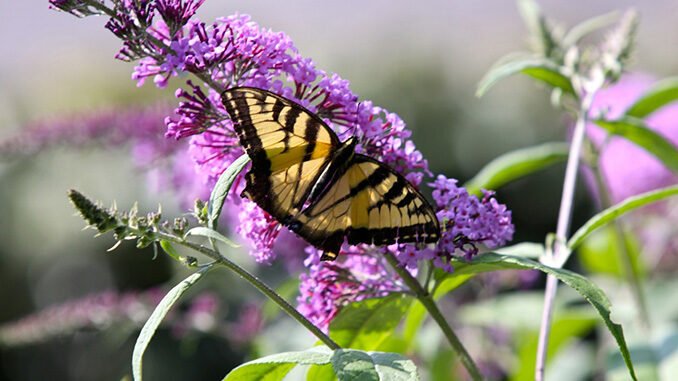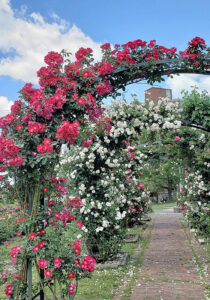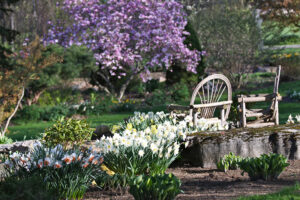
Gardens and green spaces worth visiting in the region. Some are open year-round
By Margaret McCormick
Watching our gardens come back to life after a winter that lingers into April is one of the highlights of spring and summer in Central New York. While tending to the horticulture at our homes can take a lot of time, energy and care, it’s fun to take in lush greenery, see flowers blooming and get inspired elsewhere, in more expansive gardens.
In the spirit of summer and digging in the dirt, here are some gardens and green spaces to visit in the region. Pack a picnic and stop and smell the roses and other blooms.

E.M. Mills Memorial Rose Garden, Syracuse
This is a big year for the rose garden located in Thornden Park, steps away from the Syracuse University campus. The garden, tended by members of the Syracuse Rose Society and volunteers, celebrates its 100th anniversary. Rose Day at the garden is scheduled for 11 a.m. to 3 p.m. Saturday, June 15, and the public is invited to attend. But you can visit the garden and its more than 3,000 rose bushes (and hundreds of varieties of roses) any time. June is the peak season but there is almost always something in bloom.
Information: https://syracuserosesociety.org
Sycamore Hill Gardens, Marcellus
Where can you stroll more than 30 acres of diverse trees, shrubs, perennials and spring flowering bulbs and enjoy koi ponds, fountains, stonework, statuary and a hedge maze, among other features? Sycamore Hill, the home of George and Karen Hanford. The gardens are open seasonally by reservation only for self-guided tours. See the website for admission and other details.
Information: https://www.sycamorehillgardens.com
James Pass Arboretum, Syracuse
What is an arboretum, exactly? It’s a garden dedicated to trees. The Pass Arboretum is bounded by South Avery Avenue, Tompkins Street and Salisbury Road in the Tipperary Hill neighborhood on the west side of Syracuse. The 13.8-acre park was donated to the city by Adelaide Pass, in memory of her late husband, on Arbor Day 1925. Original features, including a gardener’s house and pond, no longer exist. Today, the space “serves as a special collection of trees and a place of solitude where people can come to learn or come to relax,’’ according to the Syracuse Parks Conservancy.
Information: https://syracuseparksconservancy.org/parks/james-pass-arboretum/
Butterfly Garden of Hope, Liverpool
You’ve probably driven past the Butterfly Garden of Hope, but have you ever stopped to see it in its splendor? The butterfly-shaped garden off Onondaga Lake Parkway is a “memorial to those who have died, a symbol of hope to the living and a place of comfort for the grieving,’’ according to Hope for Bereaved, the organization that established and maintains the garden. The garden is planted with flowering trees, shrubs and plants. It’s dotted with park benches, a gazebo and other features and is available by the hour for special events (reservations are required and there is a fee).
Information: https://hopeforbereaved.com/butterfly-garden/butterfly-garden-of-hope/
Sonnenberg Gardens and Mansion State Historic Park, Canandaigua
Sonnenberg is Ontario County’s top tourist destination, attracting more than 35,000 visitors each year. Some people come to stroll in the formal gardens, while others come for a look at parts of the eclectic 40-room Queen Anne Victorian-style mansion built in 1886-1887 for New York City financier Frederick Ferris and his wife, philanthropist Mary Clark Thompson. The gardens include an Italian garden, rose garden, kitchen garden and Japanese garden. Sonnenberg is open May 2 to Oct. 31 (closed Tuesdays and Wednesdays). Admission is $16 for adults (discounts for seniors, students, youths, children and military).
Information: www.sonnenberg.org
 The Lake House on Canandaigua, Canandaigua
The Lake House on Canandaigua, Canandaigua
If you missed springtime in bloom at the Lake House, with 6,100 bulbs that span the resort, be sure to visit in summer. All flowers on the sweeping lakefront property are planted by director of horticulture John D. Faerber, who considers the grounds his canvas and loves to share his work and gardening expertise with others. If you’re in the Canandaigua area on a Saturday morning, be sure to visit the Lake House. At 9 a.m., Faerber leads hotel guests and visitors on a garden and greenhouse tour, where he showcases his work and offers tips for gardening at home. The tours are free and open to all. Arrive a few minutes early and gather in the hotel lobby. In summer, visitors can expect to see roses, lilacs, irises, peonies and more. In the greenhouse, learn about the vegetables, herbs and edible flowers that are raised for use in dishes at the hotel’s Rose Tavern restaurant.
Information: https://lakehousecanandaigua.com
Cornell Botanic Gardens, Ithaca
Spring gardens, summer gardens, fall gardens, winter gardens, “garden rooms,’’ shrubs, ornamental grasses – take a field trip to Ithaca this season or any season. The gardens and natural areas of Cornell Botanic Gardens are open dawn to dusk, free of charge, all year. There are acres upon acres of plant life to discover, so begin your visit at the Nevin Welcome Center and get a feel for what you might like to see. The center is open 11 a.m. to 4 p.m. Tuesday to Saturday. It’s surrounded by themed gardens highlighting herbs, flowers, tropical plants, vegetables and more.
Information: https://cornellbotanicgardens.org
Root Glen, Hamilton College, Clinton
The Hamilton College campus is quiet in the summer months, and the most quiet, contemplative spot of all might be the wooded and shady Root Glen. The glen, lined with shale paths for walking, is an arboretum that’s home to “65 species of trees, dozens of shrubs and scores of flowers,’’ according to the college. The glen takes its name from the Root family, who lived near today’s campus and planted and maintained its extensive collection of trees and flowering plants from 1850 to 1971, when ownership was transferred to the college. The glen is open for enjoyment from sunrise to sunset year-round.
Information: www.hamilton.edu/arboretum/root-glen

Brookwood Point Conservation Area and Gardens, Cooperstown
This diverse property, owned and operated by the Otsego Land Trust, has been described as an “outdoor classroom.’’ Brookwood Point, an estate in the Glimmerglass Historic District dating to the 1820s, features a century-old Italianate Renaissance garden, other formal gardens and excellent views of Otsego Lake. The land trust calls the 22-acre property “a melting pot of wildlife,’’ thanks to its mix of lake shore, creek and wetlands. The property, also used for private events, is open dawn to dusk daily.
Information: https://otsegolandtrust.org/brookwood-gardens
Cutler Botanic Garden, Binghamton
This four-acre demonstration garden is noted for its flower-filled paths, themed gardens and gazebo. In between are grassy areas and benches for relaxing. For the uninitiated, the Cutler Garden is one of more than 300 gardens in the U.S. designated as a display garden of All-America Selections annual and vegetable varieties. All-America Selections is a nonprofit organization that tests new varieties of plants and vegetables for home gardeners. The Cutler Garden is operated and maintained by Cornell Cooperative Extension of Broome County. It’s open dawn to dusk daily. If you’re traveling, pack a picnic and get off busy Interstate 81.
Information: https://ccebroomecounty.com/gardening/cutler-botanic-gardens
Parker F. Scripture Botanical Garden, Oriskany
The Scripture Garden is a series of about 12 gardens that peak at different times throughout the growing season, according to Cornell Cooperative Extension of Oneida County. The gardens, which surround CCE, include perennials, annuals, herbs, roses, hostas, daylilies, vegetables, pollinators, shrubs and dahlias, among others. There’s also a Butterfly House (in season) and nature trail. The garden is named for former Oneida County legislator Parker F. Scripture. It’s open daily from dawn to dusk.
Information: https://cceoneida.com/home-garden/gardening/parker-f-scripture-botanical-gardens
